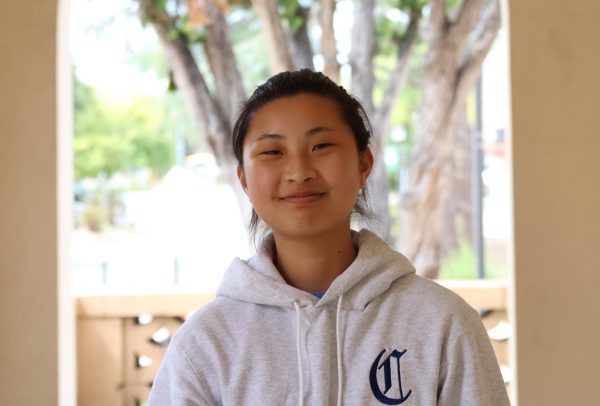Junior Alma Bendavid stares at her computer as she scans the text on the PSAT’s Math section, but after over an hour of testing, her eyes begin to glaze over as the blue light continues to glare back at her. Around her, instead of the chorus of pencils on paper, the only sounds are the almost-silent clicks or taps as other students select their right choices on each question on the newly rolled out digital PSAT.
Fortunately, Bendavid said the instructions during the digital PSAT were clear and easy to follow.
“It was organized pretty well, and everybody knew what was expected,” Bendavid said. “It increases accessibility, and it’s more practical. The fact that it’s shorter makes it a lot nicer.”
Nicole Gibbs, a senior director of the College Readiness Assessments at the College Board, said the PSAT and the SAT will no longer be administered on paper and will instead be replaced with a digital exam via the College Board’s new app, Bluebook.
Gibbs said COVID-19 helped encourage the transition to the digital tests.
“When there were widespread test center closures, it prevented us from being able to administer our assessments,” Gibbs said. “That situation really ignited a sense of urgency and purpose within our organization.”
Gibbs said the digital format will allow students to take a test with a familiar device which could expand its accessibility.
“Students are doing a lot of their learning and testing digitally, and we don’t want the SAT to be an exception,” Gibbs said. “It’s important as part of our mission to ensure that we are increasing and expanding the opportunity for students from all backgrounds.”
Assistant Principal Ladonna Butler, who is in charge of administering the PSAT and SAT at Paly, said the transition evens out the playing field for students by providing the same tools within the test.
“It allows for students to have universal supports within it,” Butler said. “(Everyone has) the calculator, zoom-in (and) zoom-out abilities, things of that nature. This means that students with accommodations can, in some instances, take the exam in a general testing (area).”
Instead of being a three-hour test like the paper SAT, the digital SAT is only two hours and 14 minutes. And in terms of the updated style of the test, the Reading & Writing and Math sections have two modules each. The modules are different sections or blocks of the test, but they contain the same type of questions.
For example, the Reading & Writing section will no longer have a distinct reading and grammar section and will instead have a mix of the two in both modules. The section will have multiple, shorter passages with one question each, compared to the previous model of very few, long passages tied to several questions.
In the Math section, instead of a calculator and non-calculator portion, both modules will allow students to use the online calculator built into the Bluebook app. Each section’s second module will have questions based on performance in the first module.
Paly College Adviser Sandra Cernobori said she hopes the shorter digital SAT will be less stressful for students.
“In some ways, I think that it will help because there’s a lot of fatigue when taking a really long test,” Cernobori said. “I would hope that that’s a bit of a stress reliever for students.”
The College Board made the digital SAT available internationally for the first time this past spring, and it will be available in the US in the spring of 2024. Gibbs said 90% of international students liked the
digital format better after they took the digital test.
“The reception has been incredibly positive,” Gibbs said. “With the digital SAT, everything is a button away and more relaxing. We have hundreds of quotes where students have said, ‘This feels easier to take,’ which is exactly what we hope to deliver to students as we were building what we believe to be an incredible experience, not just for students, but also for educators.”
Junior Kanghee Cho said the digital test format seems like mostly a good idea to him.
“The digital SAT looks easier because the passages are shorter, and you don’t have to focus that hard,” Cho said. “I think the adaptive part of it is a little questionable. I just think it’s more fair if it’s the same question for everyone.”
Gibbs said the digital SAT tailors the test to individual strengths and challenges by giving students questions with an array of difficulties that are based on their previous answers.
“It’s been designed to empower students and not to create unfair hurdles. It levels the playing field, ensuring that there’s fair evaluation,” Gibbs said. “While it feels natural to feel some level of uncertainty, I really do want to reassure students that this change is exciting, and it’s a chance to shine and be recognized for their capabilities.”
Gibbs also said the new format will likely increase security and prevent cheating.
“We have created a test form for students that is comparable and unique to that particular student,” Gibbs said. “That lessens the opportunity for students to share answers. Once the test begins, the test locks down so that the student cannot jump out of the Bluebook platform to another browser.”
And Cernobori said students shouldn’t focus too much on their SAT scores for college applications.
“A lot of what it means or the role it plays depends on the student, the high school, the college that’s using the test and how they’re using the test,” Cernobori said. “I’m not sure it’s worth students putting a lot of pressure on themselves. I would hope that students see it as one piece of the application that’s optional, but that those scores alone aren’t going to make or break an application.”
The PSAT was also digital this year, and on Oct. 11, many Paly juniors took it on campus using Bluebook.
Butler also said students should view the digitized PSAT as data necessary for their success.
“I don’t think that students should be worried about taking any exam,” Butler said. “It is an assessment to say where you’re at and these are the areas of growth, and you want to utilize that information. Especially with the PSAT, it’s going to give students information that they need to perform well on the SAT or improve on the SAT.”
Butler said before the test, administrators did training and preparations individually and as a staff.
“It’s a learning curve, but I’m enjoying it,” Butler said. “I’m excited. I think that we’re headed in the right
direction.”
Gibbs said the digital SAT presents an opportunity for students to demonstrate their knowledge to colleges and potential career opportunities.
“It allows students to showcase their true knowledge and skills and also enables them to stand out to colleges and potential career opportunities,” Gibbs said. “Those are some of the reasons why we believe that this has been a good move. I’m very confident in the way that the platform has been constructed.”


